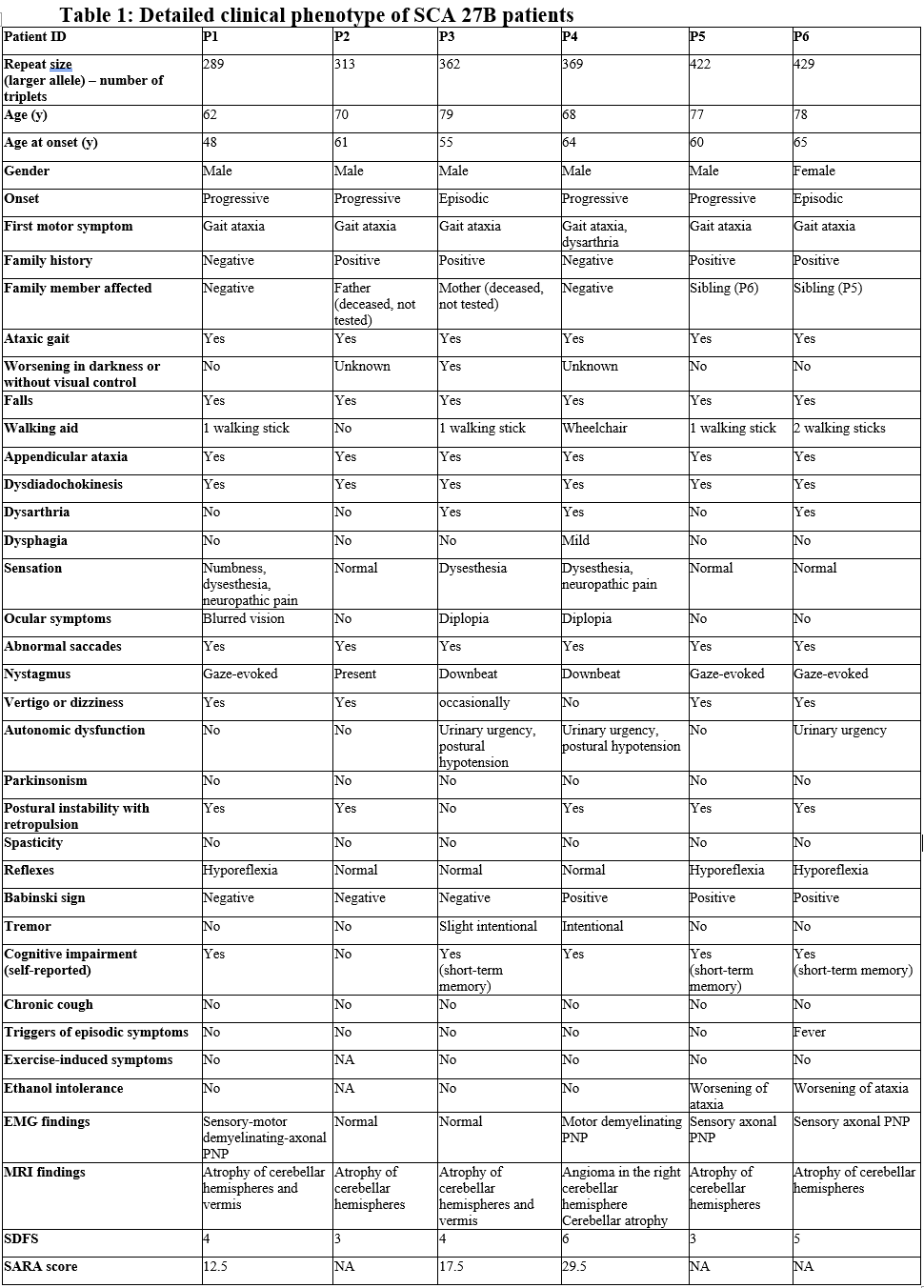Category: Ataxia
Objective: This study aimed to investigate the presence of pathogenic repeat expansion in the Fibroblast Growth Factor (FGF14) gene in patients with idiopathic late-onset cerebellar ataxia (ILOCA) in the Slovak population.
Background: The deep intronic GAA repeat expansion in FGF14 was recently described as the cause of an autosomal-dominant late-onset cerebellar ataxia (SCA27B), with heterozygous expansions larger than 250 GAA repeats considered pathogenic [1].
Method: DNA samples from 44 patients with ILOCA from Slovakia (within the CEGEMOD consortium) [2] were analysed after excluding the most frequent hereditary ataxias by long-range PCR and repeat-primed PCRs to determine the presence of pathogenic expansions in the FGF14 gene as previously described [3].
Results: Six out of 44 patients carried a pathogenic GAA expansion in FGF14 (13.6%) [Table 1]. Five of them were male (83%). The median age at onset was 60.5 years old, and four patients (66%) had a positive family history with first-degree relative affected. Two patients (33%) had episodic symptoms at disease onset. All six patients (100%) reported gait ataxia as their first motor symptom with frequent falls later that led to the need for a walking aid in five patients (83%). Appendicular ataxia, dysdiadochokinesis, abnormal saccades, and nystagmus were also present in all cases (100%) with intentional tremor in two cases (33%). Three patients (50%) reported dysesthesia or neuropathic pain and four patients (66%) had polyneuropathy diagnosed on nerve conduction studies. Parkinsonism was not present in any of the six patients. Dysautonomia was present in three patients (50%). MRI showed cerebellar atrophy in all cases (100%). Additionally, one patient had cerebellar angioma that may have contributed to his faster progression.
Conclusion: GAA pathogenic expansions in FGF14 appear to be a common cause of late-onset cerebellar ataxia in the Slovak population in comparison to other hereditary ataxias [4]. Systematic screening is thus recommended.
Detailed clinical phenotype of SCA 27B patients
References: [1] Pellerin D, Danzi MC, Wilke C, et al (2023) Deep Intronic FGF14 GAA Repeat Expansion in Late-Onset Cerebellar Ataxia. N Engl J Med 388:128–141. https://doi.org/10.1056/nejmoa2207406.
[2] Ostrozovicova M, Dusek P, Grofik, et al. Central European Group on Genetics of Movement Disorders. Eur J Neurol. 2024 Apr;31(4):e16165. doi: 10.1111/ene.16165.
[3] Bonnet C, Pellerin D, Roth V, et al. Optimized testing strategy for the diagnosis of GAA-FGF14 ataxia/spinocerebellar ataxia 27B. Sci Rep 13, 9737 (2023). https://doi.org/10.1038/s41598-023-36654-8.
[4] Ostrozovicova M, Turchetti V, Rizig M, et al. Frequency of SCA 2, 3 and 7 in Slovak patients with spinocerebellar ataxia – first report of SCA2 patient from Slovakia [abstract]. Mov Disord. 2023; 38 (suppl 1).
To cite this abstract in AMA style:
M. Ostrozovicova, J. Necpal, D. Pellerin, H. Lee, O. Shabatiuk, K. Kulcsarova, A. Lackova, V. Roth, M. Wandzel, MJ. Dicaire, M. Danzi, V. Han, L. Trckova, S. Zuchner, M. Rizig, H. Houlden, C. Bonnet, M. Renaud, B. Brais, M. Skorvanek. FGF14 repeat expansions: prevalence and case series of patients with SCA27B from Slovakia [abstract]. Mov Disord. 2024; 39 (suppl 1). https://www.mdsabstracts.org/abstract/fgf14-repeat-expansions-prevalence-and-case-series-of-patients-with-sca27b-from-slovakia/. Accessed December 6, 2025.« Back to 2024 International Congress
MDS Abstracts - https://www.mdsabstracts.org/abstract/fgf14-repeat-expansions-prevalence-and-case-series-of-patients-with-sca27b-from-slovakia/

